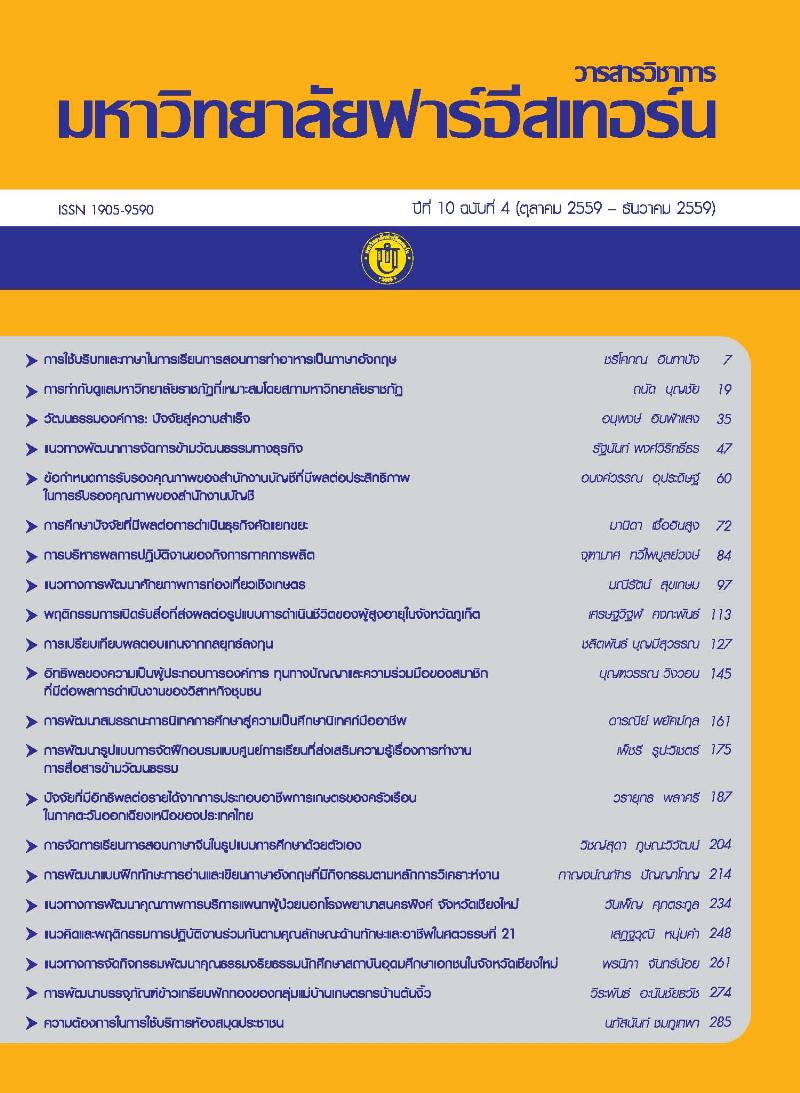การกำกับดูแลมหาวิทยาลัยราชภัฏที่เหมาะสมโดยสภามหาวิทยาลัยราชภัฏ
Main Article Content
Abstract
บทความฉบับนี้นำเสนอผลการสังเคราะห์ต่อยอดมาจากงานวิจัย เรื่อง รูปแบบที่เหมาะสมในการกำกับดูแลมหาวิทยาลัยของสภามหาวิทยาลัยราชภัฏ โดยมีวัตถุประสงค์เพื่อสังเคราะห์ผลการวิจัยเน้น
ส่วนขยายของคุณลักษณะและองค์ประกอบของรูปแบบการกำกับดูแลมหาวิทยาลัยราชภัฏที่เหมาะสม
โดยสภามหาวิทยาลัยราชภัฏ ซึ่งมี 6 องค์ประกอบ ได้แก่ 1) บทบาทและหน้าที่ของสภามหาวิทยาลัย
2) องค์ประกอบและวิธีการได้มาซึ่งนายกสภามหาวิทยาลัยและกรรมการสภามหาวิทยาลัย 3) ปัจจัยเกื้อหนุนการกำกับดูแลมหาวิทยาลัย 4) การดำเนินงานกิจการสภามหาวิทยาลัย 5) การเสริมสร้างความเข้มแข็งและพัฒนาสมรรถนะกรรมการสภามหาวิทยาลัย และ 6) การประเมินสภามหาวิทยาลัย ซึ่งผู้เขียนสังเคราะห์โดยการใช้ส่วนผสมของแนวคิดการปรับแต่งความสมดุลย์ (Alignment Model) ผนวกกับ CIPP Model
ผลการสังเคราะห์พบว่า 1) การนำโครงสร้างขององค์ประกอบของรูปแบบนี้สู่ภาคปฏิบัติ จำเป็นต้องอาศัยกลไกขับเคลื่อนในการดำเนินการ ที่แฝงด้วยกลยุทธ์ที่ผู้เขียนออกแบบมาจากการใช้ส่วนผสมของแนวคิดการมีส่วนร่วมที่พึ่งพิงฐานอำนาจทางกฎหมาย บารมีทางวิชาการและความตระหนักในบทบาทหน้าที่ของกรรมการสภามหาวิทยาลัยราชภัฏ จนกลายเป็นคุณลักษณะเด่นของรูปแบบนี้ ดังนั้น สภามหาวิทยาลัยราชภัฏจึงจำเป็นต้องประยุกต์ใช้แนวคิดการปรับแต่งความสมดุลย์ในภาพรวมเป็นกลยุทธ์สำคัญภายใต้นโยบายของรัฐและทิศทางของการพัฒนามหาวิทยาลัยราชภัฏ 2) ส่วนขยายขององค์ประกอบเพื่อให้สภามหาวิทยาลัยราชภัฏกำกับดูแลมหาวิทยาลัยที่เหมาะสม จำเป็นต้องทำเป็นระบบและใช้กลไกที่พัฒนาขึ้นจากผลการวิจัยอันจะส่งผลให้การกำกับดูแลมหาวิทยาลัย มีกระบวนการทำงานที่มีประสิทธิภาพและมีประสิทธิผล มีขั้นตอนการใช้ทรัพยากร (เวลา คน เครื่องมือ และสถานที่) อย่างประหยัด คุ้มค่า มีความคล่องตัว เกิดความสัมพันธ์ที่ดีในการทำงานร่วมกับฝ่ายบริหารได้อย่างเข้มแข็งโดยไม่มีการแทรกแซง เพื่อให้เกิดการบริหารจัดการที่ดีตามระบบคุณธรรม จริยธรรม โปร่งใส มีธรรมาภิบาล และตรวจสอบได้ และ 3) เทคนิควิทยาการที่ประยุกต์แนวคิดการปรับแต่งความสมดุลผนวกกับ CIPP Model ในบริบทของความเป็นมหาวิทยาลัยราชภัฏของสภามหาวิทยาลัยมีความเหมาะสมและมีความเป็นไปได้มากถึงมากที่สุดในการเป็นกลไกเชิงนามธรรมที่จะทำการขับเคลื่อนมหาวิทยาลัยราชภัฏทุกด้านและทุกองค์ประกอบตามคุณลักษณะเด่นของรูปแบบนี้ โดยสามารถประเมินประสิทธิภาพภายนอกและประสิทธิภาพภายในของมหาวิทยาลัยราชภัฏตามแนวคิดของธนาคารพัฒนาแห่งเอเชีย
This article aimed to present the synthesized results as an extended outcome of the research on “the Appropriate Model for Monitoring Universities of Rajabhat University Councils”, with an objective to synthesize that research result by focusing on the model’s characteristics and 6 components. They consisted of 1) roles and responsibilities of the university council, 2) elements and selection methods of the council president and members, 3) supporting factors for university monitoring, 4) the council performances, 5) empowerment and development of the council members’ competencies, and 6) the council assessment. The synthesis was conducted by the use of mixed concepts between the alignment model and CIPP Model. The synthesis results were as follows. 1) The implementation of this model component structure needed to apply the strategic driving mechanism, of which the model characteristics had been designed by the author from the mixed concepts of participatory, legitimate-power based, academic charismatic, and self-awareness approaches. So, the council had to apply the alignment concept collectively to keep the policy implementation in balance between the Government policy and the Rajabhat University’s directions. 2) An extension of the model component implementation by the council appropriately needed a systematic approach and the mechanism, as developed by the author, for university monitoring with efficient and effective process of performances, procedural usage of resources (time, human, instruments and places) with cost-effectiveness, flexibility, good inter-relationships with the administrative sector without any intervention. This executively monitoring would result in a good governance, ethics, transparency and accountability. 3) The application technique of using the mixed concepts of alignment and CIPP model within the Rajabhat University monitoring context by the university council was found most appropriate and feasible as its intangible driving mechanism in all aspects and components in line with the model characteristics. The Rajabhat University council performances could be evaluated by the use of Asian Development Bank’s concepts of external and internal efficiency.
Article Details
1. Any views and comments in the Journal of Social Innovation and Lifelong Learning are the authors’ views. The editorial staff have not to agree with those views and it is not considered as the editorial’s responsibility.
2. The responsibility of content and draft check of each article belongs to each author. In case, there is any lawsuit about copyright infringement. It is considered as the authors’ sole responsibility.
3. The article copyright belonging to the authors and The Far Eastern University are copyrighted legally. Republication must be received direct permission from the authors and The Far Eastern University in written form.
References
ถนัด บุญชัย, อนุรักษ์ ปัญญานุวัฒน์, ชูชีพ พุทธประเสริฐ, และประพันธ์ ธรรมไชย. (2558). รูปแบบที่เหมาะสมในการกำกับดูแลมหาวิทยาลัยของสภามหาวิทยาลัยราชภัฏ. ดุษฎีนิพนธ์ปริญญาศึกษาศาสตรดุษฎีบัณฑิต สาขาวิชาการวิจัยและพัฒนาการศึกษา, มหาวิทยาลัยเชียงใหม่.
ถนัด บุญชัย. (2559). รูปแบบที่เหมาะสมในการกำกับดูแลมหาวิทยาลัยของสภามหาวิทยาลัยราชภัฏ. วารสารการวิจัยกาสะลองคำ มหาวิทยาลัยราชภัฏเชียงราย. 10(1), 127-146.
สุชาดา กีระนันทน์. (2556). แนวทางการพัฒนาสภามหาวิทยาลัยในอนาคต.
จดหมายข่าวธรรมาภิบาลมหาวิทยาลัย สถาบันคลังสมองของชาติ. 3(4), 8.
Koller, T. (1994). What is value-based management?. McKinsey Quarterly. 3(1). 87-101
Porter, M.A. (1992). Increasing Time-on-task in the Classroom: Suggestions for Improving the Amount of Time Learners Spend in On-task Behaviors. Intervention in School and Clinic, 28(1), 22-27.
Stufflebeam, et al. (1971). The Relevance of the CIPP Evaluation Model for Educational Accountability. Ohio State Univ., Columbus. Evaluation Center.
Webb, N.L. (1997). Research Monograph No.6. Criteria for Alignment of Expectations and Assessments in Mathematics and Science Education. Washington, D.C. Council of Chief State School Officers.

